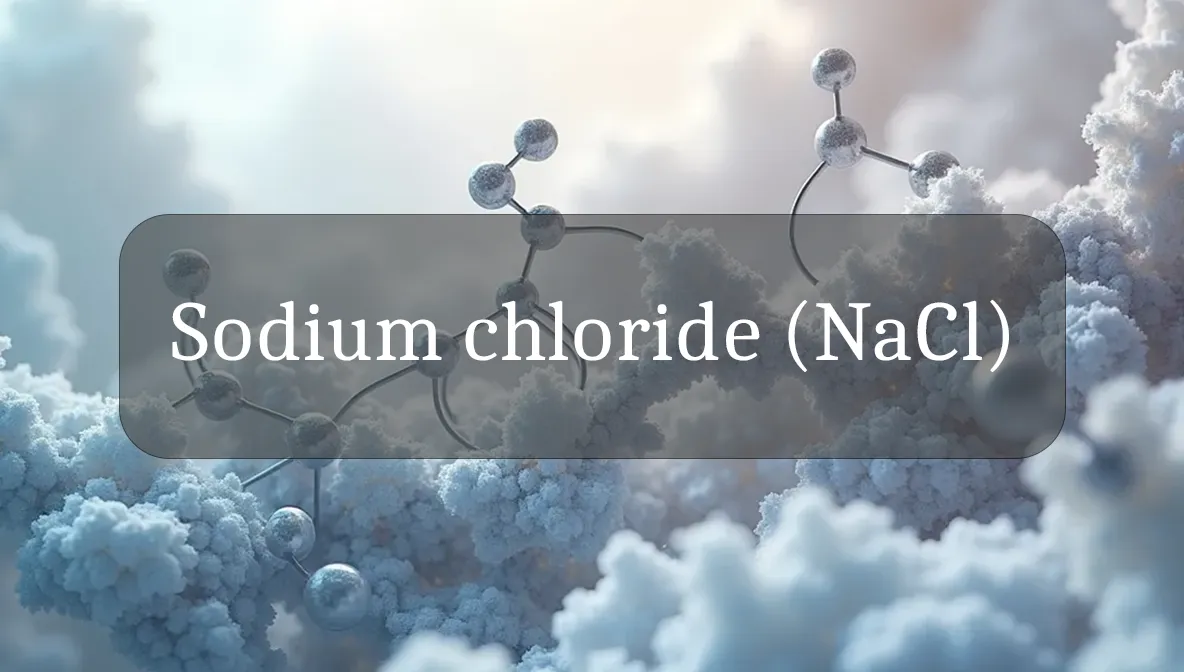Body’s Essential Electrolyte
Sodium chloride (NaCl), commonly known as table salt, is a vital compound that provides sodium (Na⁺) and chloride (Cl⁻) ions, key electrolytes for fluid balance, nerve function, and muscle activity. Found in foods, water, and added during cooking, it’s essential in moderation but requires careful management to avoid health risks from excess or deficiency. Let’s explore what sodium chloride is, its role in your wellness, and how to balance it for daily vitality.
Identity and Function
Sodium chloride is an ionic compound (~58 Da) formed by sodium and chloride ions in a 1:1 ratio. In the body, it dissociates into Na⁺ and Cl⁻, which are absorbed in the gut, distributed via blood, and regulated by kidneys. Sodium maintains fluid balance, nerve signaling, and muscle contraction, while chloride supports acid-base balance, digestion, and cell membrane stability. Homeostasis keeps plasma sodium at ~135–145 mmol/L and chloride at ~95–105 mmol/L.
Biological Role and Health Impact
Sodium chloride is critical for core physiological functions:
- Fluid Balance: Na⁺ regulates extracellular fluid volume, ensuring proper hydration and blood pressure. It works with kidneys to retain or excrete water.
- Nerve Function: Na⁺ drives action potentials in neurons, enabling brain signaling, sensation, and motor control, supporting cognition and reflexes.
- Muscle Activity: Na⁺ triggers muscle contractions, including heartbeats, maintaining strength, endurance, and cardiac rhythm.
- Digestion: Cl⁻ forms hydrochloric acid (HCl) in the stomach, aiding protein digestion and killing pathogens, supporting nutrient absorption.
- Acid-Base Balance: Cl⁻ acts as a buffer, stabilizing blood pH (~7.35–7.45), preventing acidosis or alkalosis.
By supporting hydration, nerve, and muscle function, sodium chloride keeps you energized, alert, and healthy.
Production and Sources
Sodium chloride is not produced by the body but obtained externally:
- Natural Sources: Found in seawater, mineral deposits, and foods like celery (80 mg Na/100g), seaweed, or shellfish. Soil and water contribute trace amounts.
- Dietary Sources: Table salt (40% Na, 1g = 400 mg Na), processed foods (bread, 200–400 mg/slice; canned soup, 700–1000 mg/serving), cheese (200 mg/30g), and condiments (soy sauce, 1000 mg/tbsp). Most intake (~75%) comes from processed foods.
- Key Nutrients: Potassium (bananas, spinach) balances sodium’s effects on blood pressure. Magnesium (nuts, greens) supports electrolyte function. Hydration aids ion regulation.
- Environmental Exposure: Salt in well water or coastal areas may add minor amounts but is not a primary source.
A balanced diet with minimal processed foods meets sodium chloride needs.
Signs of Imbalance
Sodium chloride imbalances, from deficiency or excess, can disrupt health:
- Sodium Deficiency (Hyponatremia):
- Symptoms: Confusion, headache, nausea, muscle cramps, or seizures from low blood sodium (<135 mmol/L). Caused by excessive water intake, sweating, or conditions like kidney disease.
- Rare in healthy diets but seen in athletes (overhydration) or heart failure. Can be life-threatening if severe.
- Chloride Deficiency (Hypochloremia):
- Symptoms: Weakness, fatigue, or irregular heartbeat from low chloride (<95 mmol/L). Often linked to vomiting, diuretics, or metabolic alkalosis.
- Rare but may occur with severe dehydration or cystic fibrosis.
- Sodium Excess (Hypernatremia):
- Symptoms: Thirst, swelling, high blood pressure, or confusion from high sodium (>145 mmol/L). Chronic excess raises heart disease risk.
- Common from high-salt diets (average U.S. intake: 3400 mg Na/day vs. recommended 2300 mg). Processed foods are key culprits.
- Chloride Excess (Hyperchloremia):
- Symptoms: Acidosis, rapid breathing, or lethargy from high chloride (>105 mmol/L). Rare, often tied to dehydration or kidney issues.
If you notice swelling, confusion, or blood pressure changes, see a doctor for tests like serum electrolytes, urine sodium, or kidney function.
Supporting Healthy Function
To optimize sodium chloride intake and maintain health:
- Limit Sodium Intake: Aim for <2300 mg sodium/day (1 tsp salt), ideally 1500 mg for heart health (AHA). Read food labels and choose low-sodium options (<140 mg/serving).
- Eat Whole Foods: Focus on fresh fruits (apples, berries), vegetables (broccoli, carrots), lean proteins (chicken, tofu), and whole grains (quinoa, oats) to reduce processed salt intake.
- Balance Electrolytes: Include potassium-rich foods (potatoes, avocados; 4700 mg/day) to counter sodium’s blood pressure effects. Stay hydrated (8–12 cups water/day).
- Season Smart: Use herbs, spices, lemon, or vinegar for flavor instead of salt. If using salt, choose iodized for added iodine benefits (45 µg/g).
- Monitor Activity: Replace sodium lost in sweat (e.g., 500–1000 mg/hour intense exercise) with sports drinks or salty snacks (pretzels, 200 mg/30g) only during prolonged activity (>1 hour).
Safety and Precautions
Sodium chloride is safe in moderation but requires care:
- Medical Conditions: Hypertension, heart failure, or kidney disease increase sensitivity to sodium, needing stricter limits (<1500 mg/day). Hyponatremia risk rises in liver disease or SIADH.
- Medications: Diuretics, ACE inhibitors, or steroids alter sodium balance. Monitor electrolytes with your doctor if on these drugs.
- Excess Risk: Chronic high sodium (>3400 mg/day) raises risks of stroke, heart attack, or kidney damage. Reduce processed foods (pizza, deli meats) and restaurant meals.
- Deficiency Risk: Athletes, those on low-sodium diets, or with heavy sweating/vomiting are prone to hyponatremia. Ensure balanced intake during high activity.
- Children’s Safety: Limit sodium in kids (<1200 mg/day for ages 4–8) to protect developing kidneys. Avoid salty snacks and check labels.
If you have blood pressure issues, swelling, or electrolyte symptoms, consult a healthcare provider for tests like electrolyte panels or blood pressure monitoring.
Fun Fact
Did you know salt was once worth more than gold? In ancient Rome, soldiers were paid in salt (hence “salary”), and it was so precious it sparked trade routes and wars—talk about a salty deal!
Citations
- National Institutes of Health (NIH): Sodium Fact Sheet for Health Professionals.
- American Heart Association (AHA): Sodium and Cardiovascular Health.
- Centers for Disease Control and Prevention (CDC): Sodium Reduction.
- Journal of the American College of Cardiology: Sodium Intake and Health (2020).
- Nutrients: Electrolyte Balance and Sodium Chloride (2021).

